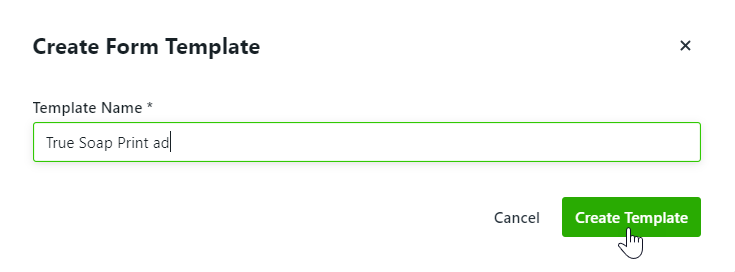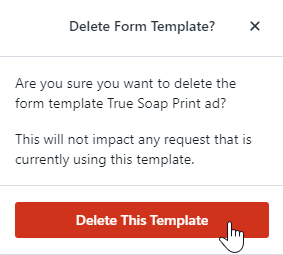Requests are the basis of every successful project. That's why we built Self-Service Form Builder to empower customers to create and edit simple forms and manage elements of complex forms on their own. Now, you can get hands-on with your forms to design and experiment with your own request creations.
Accessing Form Templates
To access the Self-Service Form Builder, select Templates on your global navigation menu and then select Forms.

You may see complex forms already published in your account. Complex forms contain advanced logic such as dependent fields or tag calculations. Once logic is added to a form, it can only be edited by our support team. For changes to complex forms, please email support@inmotionnow.com with your change request.
While complex forms cannot be edited, you can perform the below actions:
- Duplicate or delete the form
- Preview the submitted form
- Manage the 'auto-assign users' toggle
- Manage the requester list
Form Building Tools
Standard Fields
Standard Fields can be used multiple times while building a form and give you the ability to provide actionable options to be filled out by your requesters.

The Checkbox allows the requester to check a provided value.

The Dropdown allows the requester to select one value from a list of provided values.

The Multi-select allows the requester to select multiple values from a list of provided values.

Radio Buttons allows the requester to select one value from a horizontal display of provided values.

Allow requesters to select a Date.

Longform Text allows the requester to provide longer text answers and utilize line breaks when needed.

Text Box allows the requester to provide short text answers.

The Number inserts a text field that only allows requesters to enter a number.
Metadata
Metadata options can only be used once per form to provide contextual information for the request, associated work, and reporting.

Due Date provides an area for the requester to select a due date for the associated work. The date selected will be automatically mapped once the request is accepted.

Campaigns provides an area in which the requester can associate the request with an open campaign.
*Only available to Business and Enterprise Tiers

Project Template allows you to designate a project template that will be used to build out the associated project when the request is approved. This will be hidden from the requester.

Attachments provides an area for the requester to provide files via upload or through a direct link.

Acceptors provides an area where you can configure who the acceptors of the request will be. This will be hidden from the requester.

Tags allows you to determine which tags will be assigned to the associated work. This will be hidden from the Requester.
Static Elements
Static elements can be added multiple times in a form and provide form structure and additional information to the requesters.

Columns give you the ability to organize form elements so that they are side-by-side.

Link gives you the ability to provide a hyperlink for the requester.

Section gives you the ability to group fields for easier bulk movement.

Static Text gives you the ability to provide text instructions or a header.
Custom Fields
*Only available to Business and Enterprise Tiers
Custom Fields can only be used once per form. If you have Custom Fields set up in your account, these will appear in your form tools as fields, giving you even more control to receive the information you need specific to your organization.
Creating a New Form Template
In the top right-hand corner of your Forms screen, click Add Template.

Create a name for your form and click Create Template. The name can be edited once inside the designer. Once published, this is the name your requesters will see in their Request Form list.

Field Navigation
Add a field by clicking or clicking and dragging the field into the form creation area.

The field name can be edited by clicking into the text box.

Click Edit to update the information based on the field you have selected. You can also select the actions menu to Edit or Delete the field.

You can drag and drop fields, making it easy to update their placement at any point during the building process.

Request Preview
During the building process, you can preview your form at any time by clicking the REQUEST PREVIEW tab. This view is interactive, allowing you to fill out the fields and experience the form as your requesters will.

The SUBMISSION PREVIEW tab gives you the ability to view what the form will look like when submitted by the requester. You will need to fill out the fields in Request Preview to accurately view this.

Save & Publish
Requesters can only select published forms. Changes will be saved automatically and your form template will remain a draft until published. Once ready to publish your form, click Publish Template in the bottom right-hand corner of the form builder.

Deleting a Form Template
Deleting a form template is permanent. If you need to temporarily remove access to a form, select Edit Template. This will unpublish the form and move it to your Draft section for future updates. As a reminder, forms in Draft states will not be available for any new requests.
To delete a form, navigate to the action menu in the top right-hand corner of the form builder and click Delete.

To confirm, click Delete This Template.
